| Obverse Design | Almost identical to a legitimate 1934 Un Balboa. The legend along the top says "UN BALBOA" with a diamond-shaped divider on either side of the legend and between the two words. "UN BALBOA" means "ONE BALBOA", and "BALBOA" is the name of Panama's currency. The bust of Vasco Nunez de Balboa, the Spanish explorer who settled in Panama and discovered the Pacific Ocean. Balboa is wearing a marion helmet and corselet armour. To the right and left of Balboa are partial wreaths of oak leaves on one side and laurel leaves on the other. This obverse design was created and sculptured originally by William Clark Noble of Newport, Rhode Island. | |||||
| Reverse Design | Almost identical to a legitimate 1934 Un Balboa. The central figure is a woman who is an allegorical representation of liberty and youth. In her left arm is a fasces, which is an axe enclosed in a bundle of rods. This is an ancient Roman symbol of power and was used on the United States Mercury dimes. She is holding an oak branch and the top of a shield in her right hand. The shield has Panama's coat of arms. Panama's coat of arms is divided into two cantons at the top, two cantons at the bottom and a double wide canton in the center. The upper left canton is a crossed rifle and sword. It originally meant "Good bye forever to civil wars, cause of our ruin". In 1914 the meaning was changed to "Attitude of alertness in defense of our sovereignty." The upper right is a crossed hoe and shovel refering to the labor required to build the republic. The lower left is a cornucopia horn of plenty symbolizing richness and agriculture. The lower right has a wheel with wings symbolizing the speed of progress. The center canton shows land (the isthmus of Panama) between two oceans (the Atlantic and Pacific) with a sea level canal between the oceans. The sun is setting on the mountains in the west and the moon is rising over the waves in the east. This represents the solemn hour of Panama's declaration of independence from Columbia in 1903. A banner is draped over the shield with the latin motto "PRO MUNDI BENEFICIO" meaning "FOR THE BENEFIT OF THE WORLD" refering to the Panama Canal. Along the upper edge the legend "REPUBLICA" ("REPUBLIC") appears to the left of the woman as we view the coin and "DE PANAMA" ("OF PANAMA") appears to the right. Between the "DE PANAMA" and the woman are the legends "LEY 0.900" and "GR. 26.73". "LEY" means "LAW" and the legend means that the coin is .900 pure silver by law. "GR." is an abbreviation for grams, and the legend means that the coin weighs 26.73 grams. Of course, this counterfeit is probably lead. The date (1934) appears to the left of the woman's feet as we view the coin. The reverse was originally designed by a well-known Panamanian artist Roberto Lewis. | |||||
| Comparison |
This counterfeit, while trying to imitate the genuine coin, looks a little wrong to those familiar with the real thing. Upon examination, there are many differences. The easiest distinction to spot is the distance between the edge of the coins and the lettering which occurs on both the obverse and reverse. The design on the counterfeit is a little smaller than the original, so the spacing between the edge and the design is wrong. The toning on the coin is not the normal colors, and wear reveals a bluish metal instead of white. The details on the marion helmet on the obverse are more prominent and less delicate than the Noble design and look more like the 1953 Mexico City Mint design. The eyes of Balboa are different as are the dashes in the legend (see below). On the reverse, the face of the lady representing liberty and youth looks like a caricature rather than the sculpted features of the genuine coin (see below). The cornucopia in the bottom left of the shield is thinner and has less fruit. Placed on edge next to a real coin, you will also note that this counterfeit is about 1 mm bigger in diameter. |
|||||
|
Detail On Obverse The Coin on the Right is Genuine |
Detail On Reverse The Coin on the Right is Genuine | |||||
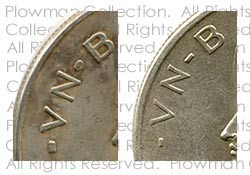
Note the spacing between the letters and the rim. Also note the shape of the dividers (thin versus thick). |
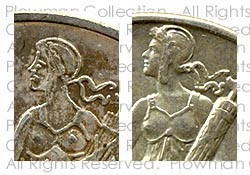
Note the spacing between the lady and the rim. Also note the difference in facial features. | |||||
| Metal | Appears to be lead with a thin top layer of silver. | Size and Shape | Round, 39 mm in diameter (genuine coin is 38 mm). | Weight | 26.58 grams. Genuine coin should weigh about 26.73 grams. | |
| Rarity | Scarce. I've noticed two for sale on ebay within 18 months. | |||||
| Source | Plowman Collection, purchase from a Canadian seller. | |||||
| Notes |
The origin of these counterfeits may be Asia, perhaps Hong Kong or China. One of the sellers of these counterfeits was from China and claimed to be selling coins acquired locally. I would appreciate e-mail from anyone who can add anything to this information. |
|||||
The Coin on the Right is Genuine
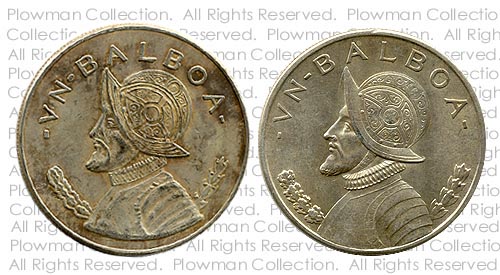
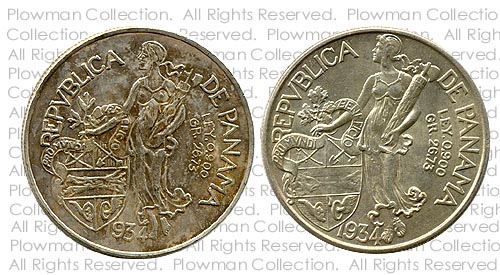
Scale: 6 pixels equals one millimeter
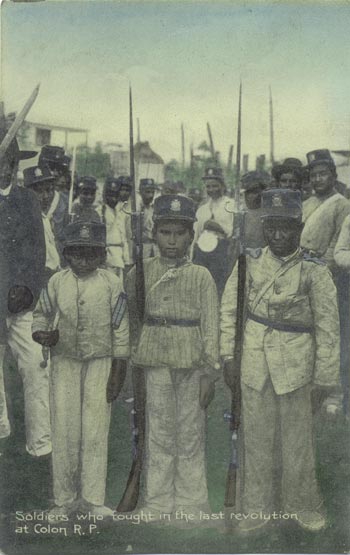
From Irvin & Thomas Post Card No. 3517.